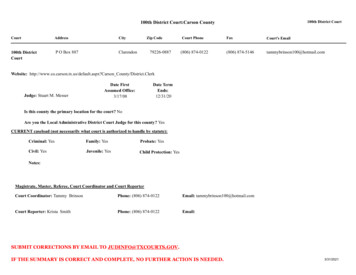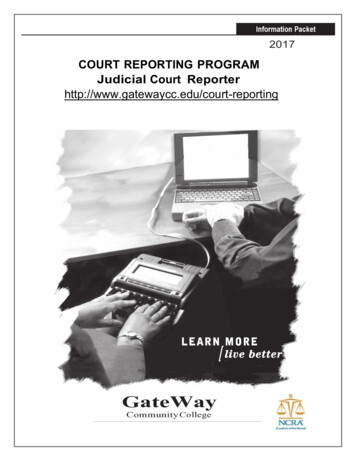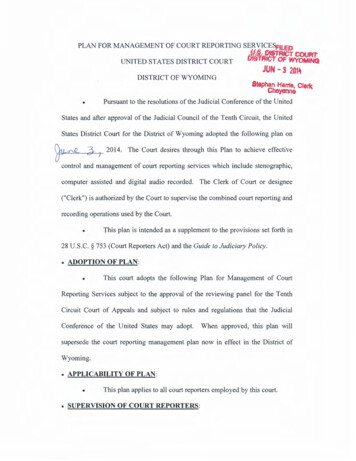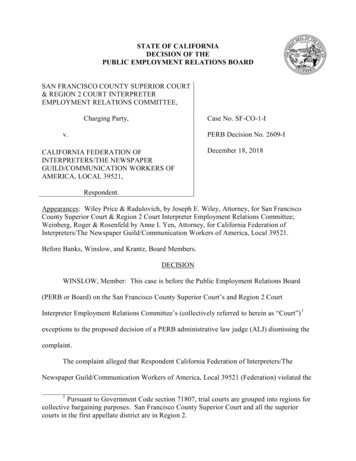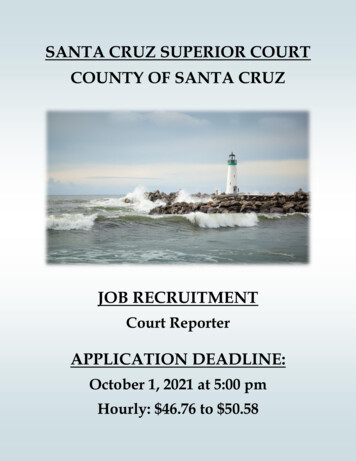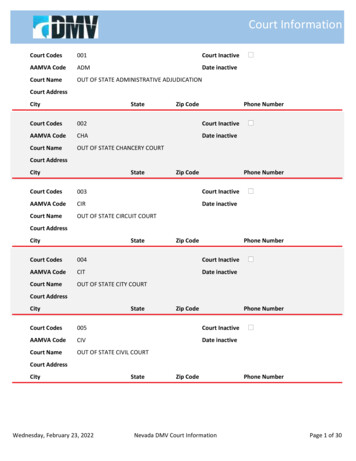
Transcription
IN THE HIGH COURT OF SOUTH AFRICA(EASTERN CAPE - GRAHAMSTOWN)Case No: 1062/2001Heard on:19 November 2009Delivered:14 December 2009In the matter between:WILMOT MANDLA CHAGI & 29 OTHERSPlaintiffsandSPECIAL INVESTIGATING UNIT AND 9 OTHERSDefendantsJUDGMENTKROON J:[1]This judgment concerns a number of exceptions delivered by the plaintiffs to thepleas filed by the defendants in the proceedings.[2]The plaintiffs initially issued summons in this matter on 14 August 2001. At thatstage the parties cited were reflected as follows:Special Investigating Unit1st DefendantMEC for Agriculture and Land Affairs(Eastern Cape)2nd DefendantDaily Dispatch Media (Pty) Ltd3rd Defendant
(In fact, the correct name of the 3rd defendant is Dispatch Media (Pty) Ltd).[3]Claim A made the following allegations: On 25 August 1998 the 1 st and 2nddefendants, in founding papers filed in proceedings before the Special Tribunal,made certain defamatory statements concerning the plaintiffs (in essence relating toalleged misappropriation of funds belonging to the Transkei Agricultural CorporationLtd (Tracor)). The statements were published to various persons. In consequencethereof the plaintiffs had each suffered damage for which the 1st defendant is liable.(My italics).[4]Claim B made the following allegations: At a conference held on 24 August 1998the second defendant made and published certain defamatory statementsconcerning the plaintiffs (of a similar ilk as those referred to in paragraph 3 above).Accordingly, the 2nd defendant is liable to the plaintiffs for damages.[5]Claim C alleged that on 21 August 1998 the 1st and 2nd defendants maliciously setin motion certain legal proceedings against the plaintiffs making false allegationsagainst them. Accordingly, the two defendants were jointly and severally liable to theplaintiffs for damages.[6]Claim D alleged that on 25 August 1998 the 3rd defendant published, in anewspaper owned and published by it, an article which was defamatory of theplaintiffs. Accordingly, the defendant was liable to the plaintiffs in damages.
[7]The 1st and 2nd defendants filed their plea on 15 November 2001, which embracedcertain special pleas and a plea over. The plea of the 3 rd defendant, on the merits,was delivered on 27 August 2002.[8]Various skirmishes took place between the plaintiffs and the 1st and 2nddefendants concerning the special pleas filed by the latter. The upshot was thatjudgments upholding the special pleas and dismissing claims A, B and C were setaside, and the matter was remitted to this Court for further adjudication.[9]The plaintiffs thereupon applied for, and were granted, an order joining the 4th to10th defendants.The plaintiffs’ amended combined summons, embracing thejoinder, was delivered on 8 July 2009. The 4th to 6th defendants, the Government ofthe Republic of South Africa, the State President of the Republic of South Africa andthe Minister of Justice and Constitutional Development, were cited as interestedparties (on the basis that they were functionaries of the State and the latter was thetrue party that would satisfy any judgment given against the 1st defendant in favour ofthe plaintiffs – see Chagi and Others v Special Investigating Unit 2009 (2) SA 1 (CC)paragraph 42 at 15E). The 7th to 10th defendants, the Premier of the Eastern CapeProvince, the Minister of Agriculture and Land Affairs, the Executive Council of theEastern Cape and the Eastern Cape Provincial Government, were also cited asinterested parties “who are implicated in the commission by them of unlawful acts committedduring the purported dissolution of Tracor and its implementation as demonstrated in these particularsof claim”.Various factual allegations were included in the amended particulars ofclaim relating to conduct on the part of these defendants and the 4 th defendant. No
relief was, however, claimed as against the 4th to 10th defendants. (This is an aspectto which I will revert later).[10]In response to the amended particulars of claim the 1st, 2nd and 4th to 10thdefendants filed an amended plea, which included various special pleas in limine.The 3rd defendant did not file an amended plea.[11]On 14 September 2009 the plaintiffs delivered an exception to the amended pleaof the firstmentioned defendants (relating to the special pleas in limine as well as theplea on the merits) and to the 3rd defendant’s existing plea on the merits. (At thesame time a replication to the amended plea was filed).Thereafter, on 21September 2009, the plaintiffs gave notice of their intention to amend the exceptionby limiting same to the exceptions to the special pleas in limine of the 1st, 2nd and 4thto 10th defendants and deleting the exceptions to the pleas on the merits of thesedefendants and of the 3rd defendant. That amendment was duly effected and theamended exception was delivered on 12 October 2009.[12]At that stage therefore the only exception on the table was the plaintiffs’amended exception, to the special pleas in limine of the 1st, 2nd and 4th to 10thdefendants. (For convenience this exception will be referred to as the special pleasexception).[13]However, on 26 October 2009 the plaintiffs’ attorney filed and delivered adocument styled “PLAINTIFFS EXCEPTION TO THE 1ST, 2ND, 4TH TO 10TH DEFENDANTS’AMENDED PLEA AND TO THE 3RD DEFENDANT’S PLEA”(and dated 15 October 2009).
This document purported to constitute an exception to the defendants’ pleas on themerits.(For convenience this exception will be referred to as the merits pleasexception).[14]At the hearing on 19 November 2009 the first issue raised for resolution waswhether the merits pleas exception was properly before me and could beentertained. I made an order setting aside the exception as an irregular proceedingand I indicated that my reasons for the order would be furnished in due course. Thereasons follow.[15]On 17 November 2009 the 1st, 2nd and 4th to 10th defendants filed a notice ofapplication in terms of rule 30(1). Notice was given therein that at the hearing on 19November 2009 application would be made for an order setting aside what wasreferred to as the plaintiffs’ “amended exception dated 15 October 2009” as being anirregular proceeding. (The reference was to the merits pleas exception). The 3rddefendant filed a similar notice.The plaintiffs filed papers in opposition to theapplications.[16]There is a dispute as to whether the Registrar issued the notice of set down for19 November 2009 before or after the filing of the merits pleas exception. I willproceed on the basis that, as stated in the affidavit by Mr Tshiki, who appeared forthe plaintiffs, it was after he had filed that exception on 26 October 2009 that herequested the Registrar to set the matter down for hearing on 19 November 2009 (adate which had been agreed upon between the parties), including the merits pleasexception.
[17]A point in limine, as it were, taken by Mr Tshiki was that the applications for thesetting aside of the exception were themselves irregular and should not be acceptedby the Court in that the defendants had not, as required by rule 30 (2)(b), givenwritten notice to the plaintiffs affording them an opportunity of removing the cause ofthe complaint. It was in fact the submission of the attorney that however patent andserious the irregularity was and however substantial the prejudice occasionedthereby and notwithstanding that the plaintiffs were not in a position to remedy thematter complained of, the Court is obliged to reject the application for the settingaside of the irregular step if it had not been preceded by compliance with rule 30 (2)(b), and to hear the exception.[18]In fact, however, as will appear below, there was compliance with the prescriptsof rule 30 (2)(b). Mr Pretorius, the attorney acting for the 1 st, 2nd and 4th to 10thdefendants, in an affidavit in support of the rule 30 application, stated that in the lightof the history of the matter and prior to receipt of the plaintiffs’ merits pleas exceptionon 26 October 2009 the defendants were of the view that the only exception to beadjudicated on the agreed date of hearing, 19 November 2009, was the specialpleas exception. That statement was no doubt correct. Mr Tshiki records in hisanswering affidavit that subsequent to the delivery of the plaintiff’s amendedexception (the special pleas exception) the plaintiffs’ exception to the general pleasof the defendants was reformulated with a view to delivering same afresh and in aseparate document (the merits pleas exception). He then states that he telephonedPretorius to arrange a date of set down of the exceptions and 19 November 2009was agreed upon. Conspicuous by its absence, however, was any intimation by Mr
Tshiki to Pretorius that the merits pleas exception was to be included or, indeed,even that such a document existed.[19]It may be recorded at this stage that the merits plea exception is contained in avery voluminous document comprising 77 pages and that it went considerably furtherthat the portion of the original exception filed that related to the pleas on the merits. Iwill return to this aspect later.[20]Pretorius formed the view that the merits pleas exception was irregular in that:(a) there had been no compliance with rule 28(1) in that no notice of intentionto amend the exception filed on 12 October 2009 (the special pleasexception) by the addition thereto of the merits pleas exception had beengiven;(b) no such amendment had been effected as required by the rule;(c) the defendants had not been afforded an opportunity to exercise theirrights in terms of the rule.[21]Accordingly, Pretorius addressed a letter to Mr Tshiki dated 30 October 2009and faxed to him on 4 November 2009. After referring to the history of the earlierexceptions filed by the plaintiffs Pretorius recorded that it was the defendant’s viewthat only the special pleas exception was to be adjudicated on 19 November 2009.He pointed out that the final document filed, the merits pleas exception, was
confusing in that it only related to the general pleas and not to the special pleaswhich was the content of the amended exception filed on 12 October 2009 and herequested that the position be clarified.[22]The response to the letter was dated 9 November 2009.It read in part asfollows:“Kindly ignore the content of our notice to amend to the effect that only theexception pertaining to the special plea would be argued. At that stage no datefor argument was arranged and had been set. We had thought that it might takeus some time to reformulate our client’s exception to the merits of your clients’amended plea and thought that in the meanwhile we could have the exception tothe special pleas heard but did not obtain a date in that regard. However, wewere able to reformulate the exception to the merits of your clients’ amendedplea in no time and realized that it would save costs to have the whole exceptionembracing both the special pleas and the merits heard simultaneously and in thisregard decided to set down both exceptions after arranging a dated (sic) with youas the 19th November is that date the writer obtained from Mr Pretorius.As manifest from the index we delivered on the 26 th October 2009 and the headsof argument we have delivered in the above matter and indeed the notice of setdown, both the exception to the special pleas and to the merits of your clients’pleas are to be heard on 19 November 2009.”[23]The reply, dated 10 November, read as follows:“We do not agree with your contentions in your letter of 9 November 2009.
Your clients cannot simply ignore Court Rules and amend as they please.Defendants will only prepare on and argue Plaintiffs’ Amended Exception to the1st, 2nd, 4th to 10th Defendants’ Special Pleas in limine, dated 14 September 2009and served on Defendants on 12 October 2009. Such document consists of 30pages, as stated in our letter of 30 October 2009, and it only excepts to theDefendants’ Special Pleas. These are the issues that we regard to be decided on19 November 2009.Plaintiffs’ exception to the 1st, 2nd, 4th to 10th Defendants’ Amended Plea and tothe 3rd Defendant’s Plea, dated 15 October 2009 and served on the Defendantson the 26 of October 2009, is quite clearly irregular proceeding, inter alia in that:1. As far as we are aware of, no notification of intention to amend was givenas required by Rule 28(1);2. The amendment was also not effected as required by the said Rule 28;3. The Defendants have not been given the opportunity to, within 15 daysafter the amendment had been effected, make any consequentialadjustments to the documents previously filed by them, as provided for inRule 28(8).Please confirm then that only the Special Pleas will be argued on 19 November2009, failing which we will bring an application to have the document of 15October set aside.Please revert as a matter of urgency.All our client’s rights are reserved”[24]In argument Mr Tshiki reiterated the stance adopted in his answering affidavit:The merits pleas exception was not an amendment of the existing exception but a
fresh exception following on the amendment of the original exception filed whicheffected a withdrawal of part thereof.Accordingly, the plaintiffs were entitled todeliver the exception and apply for a date for the hearing thereof in terms of rules23(1) and 6(5)(f).Put differently, the plaintiffs were entitled to reinstate thewithdrawn exception by delivering it again. It was only if the plaintiffs sought toreintroduce the merits pleas exception by way of an amendment to the existingspecial pleas exception that they would have had to follow the procedure laid downin rule 28.[25]The deponent to the affidavit filed in support of the 3 rd defendant’s application interms of rule 30 for the setting aside of the merits pleas exception as irregular was itsattorney, Mrs Norval. She invoked the same grounds as mentioned by Pretorius forthe contention that delivery of the exception was irregular. She also referred tocorrespondence that passed between her and Mr Tshiki.In a letter dated 3November 2009 she commented that having regard to the fact that the exceptionwas only delivered on 26 October 2009 it appeared that it was not to be argued on19 November 2009. By letter dated 4 November 2009 Mr Tshiki stated that bothexceptions had been set down for hearing on 19 November 2009. In a further letterdated 9 November 2009 Mr Tshiki adopted the attitude that the failure of thedefendant to respond to a notice of bar calling upon it to file an amended plea to thelatest amended particulars of claim, and its instead filing a rule 30 application for thesetting aside of the notice of bar, had paved the way for plaintiffs to file the exceptionto the existing plea.
[26]All the defendants made the point that they had been prejudiced by the deliveryof the merits pleas exception having regard to the complexity of the issues raised inits voluminous documentation.[27]In my judgment, the delivery of the merits pleas exception was an irregular stepfor the reasons that follow. First, that portion of the exception which relates to themerits plea of the 1st, 2nd and 4th to 10th defendants would indeed, if allowed, haveconstituted an amendment of the existing special pleas exception. The rules providefor the filing of an exception (itself a pleading) to a pleading filed by an opposingparty. It does not make provision for the filing of a further and separate exception tothe same pleading (even if the lastmentioned document contains discrete sections.)What the defendants in question did was to file a single, albeit composite, pleadingcontaining both its pleas in limine and its plea over. Only a single, albeit composite,exception thereto was permissible. As Mr Tshiki himself stated in his answeringaffidavit, what the plaintiffs did was (purportedly) to reinstate that part of theexception that had been withdrawn earlier (save that the new exception was morevoluminous) and that what the plaintiffs sought to do was to amplify the existingexception. That could, however, only have been effected by way of an appropriateamendment to the existing pleading. The provisions of rule 28 were accordingly ofapplication and the plaintiffs were obliged to follow the procedural steps set outtherein. That they failed to do.[28]Had the plaintiffs not so failed it would have been open to the defendants tohave filed and delivered a notice of objection to the proposed amendment. Allowingthe plaintiffs to follow the procedure they did adopt would have been wrongfully to
deprive the defendants of their entitlement to register objections to the proposedamendment. In fact, an objection which the defendants could have raised, as set outin the succeeding paragraph, constitutes a further basis on which to find that thedelivery of the exception was an irregular step. It should be recorded that the aspectin question was raised by me during argument.[29]Rule 23(3) stipulates that an exception must state the grounds on which it isfounded clearly and concisely.comprises some 77 pages.As already recorded, the exception in questionSixty pages thereof related to the plea over of thedefendants in question. It need hardly be observed that a document as prolix as thatdoes not qualify for the epithet of ‘concise’. This is the more clear when regard is hadto the facts that only a limited number of paragraphs in the amended plea over werethe subject of attack, that cognizable portions of the exceptions comprised a recordalof allegations made by the plaintiffs in the particulars of claim and of admissionsmade by the defendants in respect thereof and, more importantly, that much of theexception, indeed overwhelmingly the greater part thereof, was devoted to argumentwhy, on the facts alleged by the plaintiffs, or for other reasons, the defences pleadedought not to be upheld, as opposed to setting out grounds why the defencespleaded, even if proved, would not in law constitute defences. That was both amisuse and abuse of the exception procedure. The material referred to might, to agreater or lesser extent, have found an appropriate home in a replication. It mayalso be mentioned that in addition to a prayer that the exception be upheld, theexception inappropriately and invalidly sought a finding that the 1st and 2nddefendants, as the case may be, are liable to the plaintiffs for such damage as maybe proved.
[30]The extent to which the exception constituted an infraction of the provisions ofrule 23(3) requires it to be stamped an irregular proceeding.[31]If in fact the plaintiffs were entitled to deliver a fresh and independent exceptionin addition to the one already filed there is another reason why the delivery thereofwas an irregular proceeding.[32]Rule 23(1) provides that an exception must be delivered within the periodallowed for filing any subsequent pleading. In the case of an exception to a plea thatperiod is the one within which a replication has to be filed, ie 15 days (see rule25(1)). Save in respect of an exception to a plea an exception to another pleadingmay be filed after the stipulated period unless the opposing party had taken steps toimpose a bar to the filing of any further pleading. However, the failure to file aresponse to a plea (ie a replication or exception) within the stipulated period bringsinto operation an automatic bar against the filing of a response (see rule 26).Accordingly, the party guilty of such failure is precluded from filing a response,including an exception, unless that party has sought and secured an upliftment of thebar (either by consent of the other party or by order of court).[33]The purported delivery of the exception in the present matter was effected asubstantial period after the date on which a replication to the plea, if any, wasrequired to be filed. The plaintiffs were accordingly under automatic bar against thefiling of any further pleading. They could therefore not file and deliver an exceptionunless they had sought, and secured, an upliftment of the bar. They did not do so.
The filing and delivery of the exception was accordingly impermissible and anirregular step.[34]I turn now to deal with the portion of the exception delivered on 26 October 2009that was directed at the 3rd defendant’s plea. Consequent upon the amendment totheir exception effected by the plaintiffs on 12 October 2009 which expunged theearlier exception taken to the 3rd defendant’s plea there was no existing exception tothe defendant’s plea. The relevant part of the exception in question was accordinglynot intended to be, nor could it be, an amendment of an earlier exception (an earlierpleading). The comments made above concerning amendments to a pleading aretherefore not of application.[35]It may be accepted for present purposes (without so deciding):(a)that in the light of its filing and delivery of its final amended particulars of claimembracing the joinder of the further defendants and the inclusion of allegations inrespect of them, the plaintiffs were entitled to call upon the 3 rd defendant to file anamended plea on pain of being barred if it failed to do so;(b)that in the absence of the filing of an amended plea in response to the noticeof bar the plaintiffs were entitled, upon the bar taking effect, to file and deliver anexception to the 3rd defendant’s plea.[36]However, the exception was required to be filed within the period allowed for thefiling of a further pleading failing which the plaintiffs were automatically barred. The
plaintiffs’ notice of bar to the 3rd defendant was served on 20 August 2009. The 3rddefendant’s response thereto was to file on 21 August 2009 a notice of application interms of rule 30 for the setting aside of the plaintiffs’ notice of bar as an irregularproceeding. (An earlier notice of bar by the plaintiffs, subsequently withdrawn bythem, had elicited a similar response, the 3rd defendant’s attorneys having earlierwritten to the plaintiffs’ attorneys contending that the notice of bar was irregular in thelight of the fact the 3rd defendant had already pleaded).At best for the plaintiffstherefore the exception to the 3rd defendant’s plea should have been filed within 15days of the 3rd defendant’s notice in terms of rule 30. Having failed to do so theywere under automatic bar and could not file an exception thereafter withoutupliftment of the bar. The delivery of the exception to the 3rd defendant’s plea on 26October 2009 was accordingly an irregular proceeding.[37]Secondly, that part of the document delivered that related to the plea of the 3 rddefendant (comprising some 15 pages) attracts mutatis mutandis the same criticismas that recorded in paragraphs 29 and 30 above in respect of the part that related tothe plea over of the other defendants. Again, there was a serious infraction of theprescript in rule 23(3) that the grounds on which an exception is based are to bestated clearly and concisely, and the document was accordingly an irregularproceeding.[38]The first special plea in limine raised a defence of prescription to claims A and Bon behalf of the 2nd, 7th, 9th and 10th defendants. However, at the hearing the pleawas abandoned and the costs of the exception thereto were tendered.
[39]The second special plea in limine raised a different defence of prescription toclaims A, B and C on behalf of all the defendants (save the 3rd defendant). It soughtto meet various allegations introduced by the plaintiffs for the first time in the finalamended particulars of claim, which, so it was contended, constituted a separateand new cause of action. The allegations charged the defendants with unlawfulconduct relating inter alia to the restructuring of Tracor, the issue of the proclamationin terms of which Tracor was dissolved, the implementation of the liquidation ofTracor, the retrenchment of Tracor employees, unfair labour practices, noncompliance with the audi rule and the provisions of the Labour Relations Act, andfailure to consult the plaintiffs. The allegation related to events that occurred morethan three years prior to delivery of the plaintiffs’ amended particulars of claim;hence, the contention that the new cause of action constituted by the allegations,and the debt to which they gave rise, had become prescribed.[40]There are two short answers to the contention. First, as Mr Tshiki sought toemphasise, no relief was sought as against the 4th to 10th defendants. They werecited as interested parties. In the circumstances there can be no talk of a “debt”owing by them having become prescribed.[41]Second, Mr Tshiki correctly pointed out that on a nice analysis of the particularsof claim the allegations did not introduce a new cause of action founding a new debt.In short, the allegations went in support of the claims that the defamatory statementsand the proceedings complained about were unlawful and had been made andinstituted animo iniuriandi on the basis, in addition to the allegations alreadycontained in the particulars of claim, that the 1st and 2nd defendants were aware of
the unlawful conduct referred to in the further allegations when they made thestatements and instituted the proceedings.The cause of action and the debtinvoked remained the same.[42]The plea accordingly did not disclose a defence and the exception thereto wasvalidly taken.[43]The third special plea in limine, directed at claims A, B and C on behalf of all thedefendants, sought to raise the defence of the lack of jurisdiction of this Court toadjudicate certain issues. These related to the alleged unfair labour practices, theretrenchment of Tracor employees, non-compliance with the audi rule and theprovisions of the Labour Relations Act, and the failure to consult with the plaintiffs. Itwas again contended that the allegations constituted a new cause of action, but it isone which is justiciable only in the Labour Court.[44]The comments in paragraphs 40 to 42 above, however, apply mutatis mutandis.Moreover, as Mr Tshiki pointed out, the relief sought by the plaintiffs did not a riseout of an employment relationship.[45]The fourth special plea in limine raised the defence of res iudicata as against the1st, 2nd, 3rd, 8th, 12th and 19th plaintiffs. These plaintiffs, together with other persons,were plaintiffs in certain earlier proceedings instituted against the 2nd and 7thdefendants (Twani and Others v The Premier for the Eastern Cape and Others Caseno. 460/99, Transkei Division). I presided over those proceedings. Included in thefindings I made were findings that the audi rule was complied with, that proper
consultations were held with Tracor employees and that Tracor was lawfullydissolved. Accordingly, so it was contended, the separate and new cause of actionconstituted by the allegations on those scores by the plaintiffs in question was resiudicata.[46]It requires to be repeated that no new cause of action founding a new debt wasintroduced and that no relief is being claimed as against the 7 th defendant. Further, itwill suffice to point to the fact that the parties in the Twani matter and the presentmatter are not identical, that the causes of action and grounds relied upon are notthe same and the relief claimed in the instant case is not the same relief as wasclaimed in Twani. On the basis of the reasoning set out in paragraphs 110 to 118 ofthe first judgment I delivered in Twani and in the Sorghum Brewery case referred totherein, the issues referred to in the special plea are not res iudicata a defence wasnot disclosed and the exception thereto was validly taken.[47]Mr De Bruyn (who with Mr Pienaar) appeared for the defendants sought duringargument to refer to an exception (consisting of two parts) to the replication filed onbehalf of the plaintiffs and submitted that his clients were entitled to certain relief inrespect thereof. As pointed out by Mr Tshiki, however, that exception had not beenset down for hearing. It is assumed that the parties’ attitude to that exception will beinformed by the contents of this judgment.[48]It may be mentioned that the conclusions recorded above do not bear on therights of the defendants to object at the trial to the admissibility of evidence on the
factual issues raised in the special pleas in limine with reference to the relevancethereof.[49]The following orders will accordingly issue:(a) The applications of the defendants in terms of rule 30 are upheld and theexception delivered by the plaintiffs on 26 October 2009 is set aside as anirregular proceeding, with costs, such costs to include the costs of twocounsel, and to be paid jointly and severally, the one plaintiff paying, theothers to be absolved.(b) The defendants (excluding the 3rd defendant) will pay the plaintiffs’ costs ofthe exception to the first special plea in limine of the defendants jointly andseverally the one paying the others to be absolved.(c) The plaintiffs’ exceptions to the second, third and fourth special pleas inlimine of the defendants (excluding the third defendant) are upheld and thespecial pleas in limine are struck out, with costs, jointly and severally, theone defendant paying, the others to be absolved.F KROONJudge of the High Court
14 December 2009Appearances:For Plaintiff:Mr Tshikic/o Whitesides Attorneys53 African StreetGrahamstown (Mr Barrow/Louise)Instructed by:Tshiki and Sons IncorporatedFor 1st,2nd, 4th – 10th Defendants:Adv de Bruyn & Adv Pienaar instructed by:The State Attorneyc/o G M Yeko3F Anglo African StreetGrahamstownFor 3rd Defendant:Adv de Bruyn & Adv Pienaar instructed by:Netteltons Attorneys118A High StreetGrahamstown
relief was, however, claimed as against the 4th to 10th defendants. (This is an aspect to which I will revert later). [10]In response to the amended particulars of claim the 1st, 2nd and 4th to 10th defendants filed an amended plea, which included various special pleas in limine. The 3rd defendant did not file an amended plea. [11]On 14 September 2009 the plaintiffs delivered an exception to .




